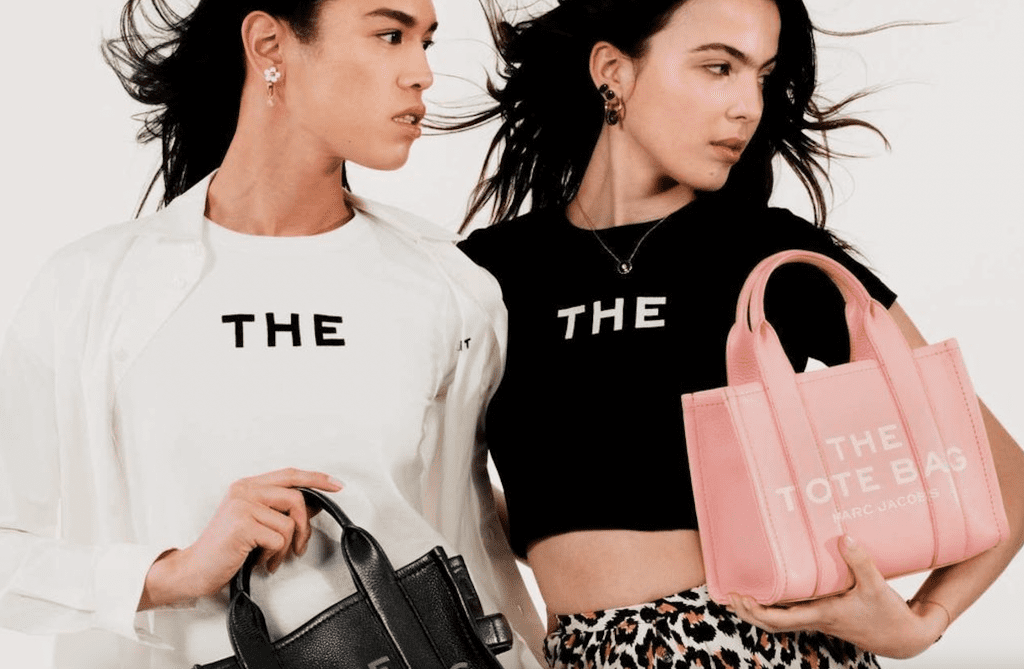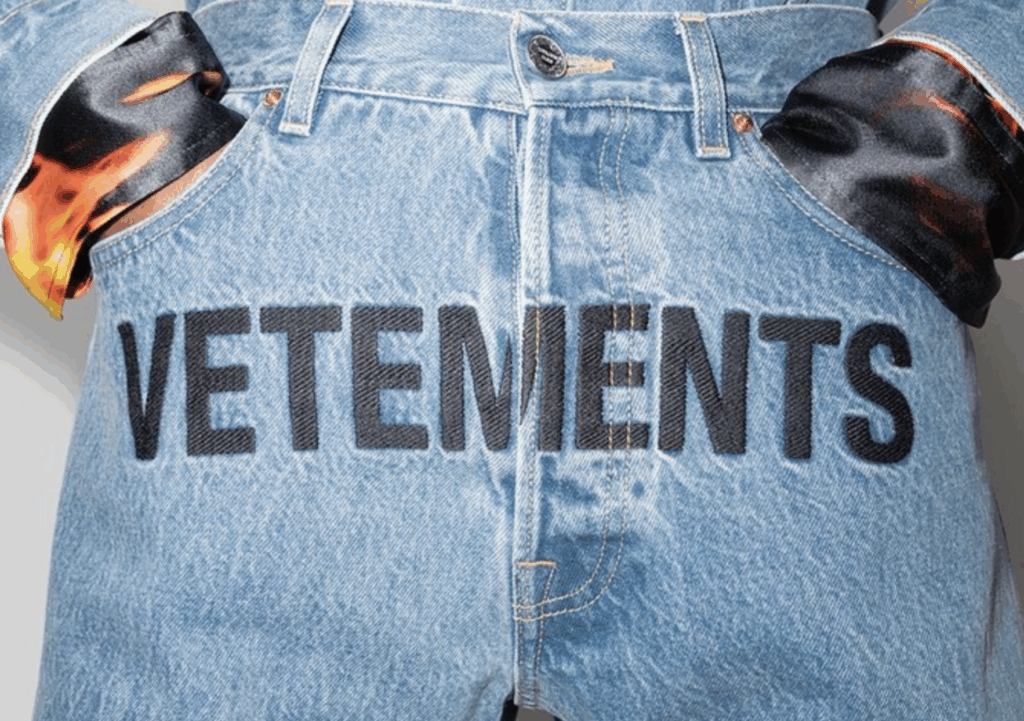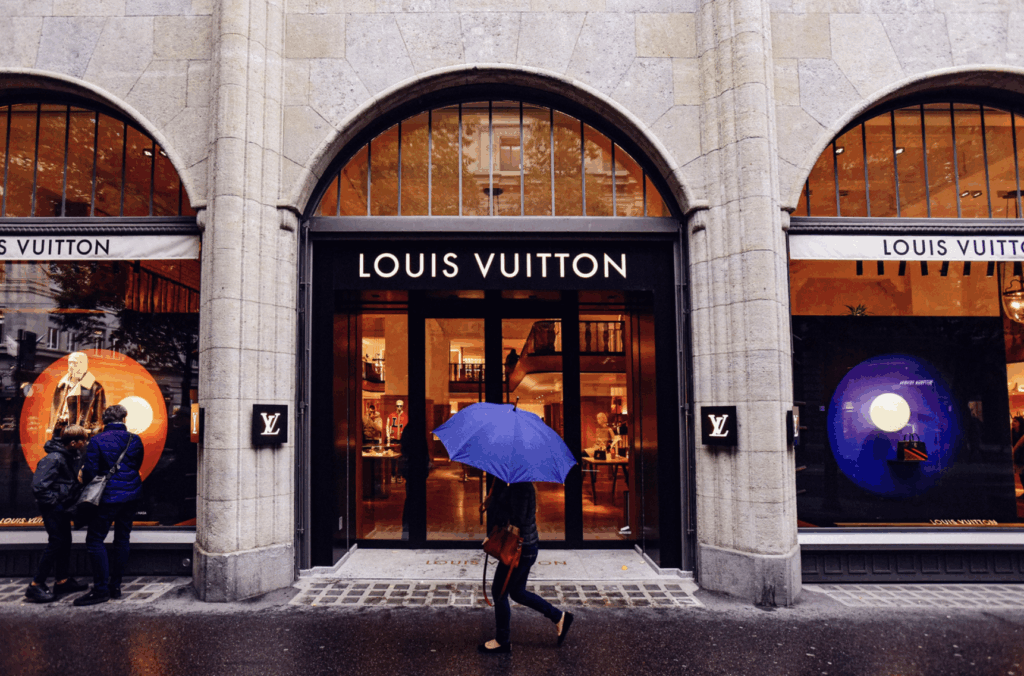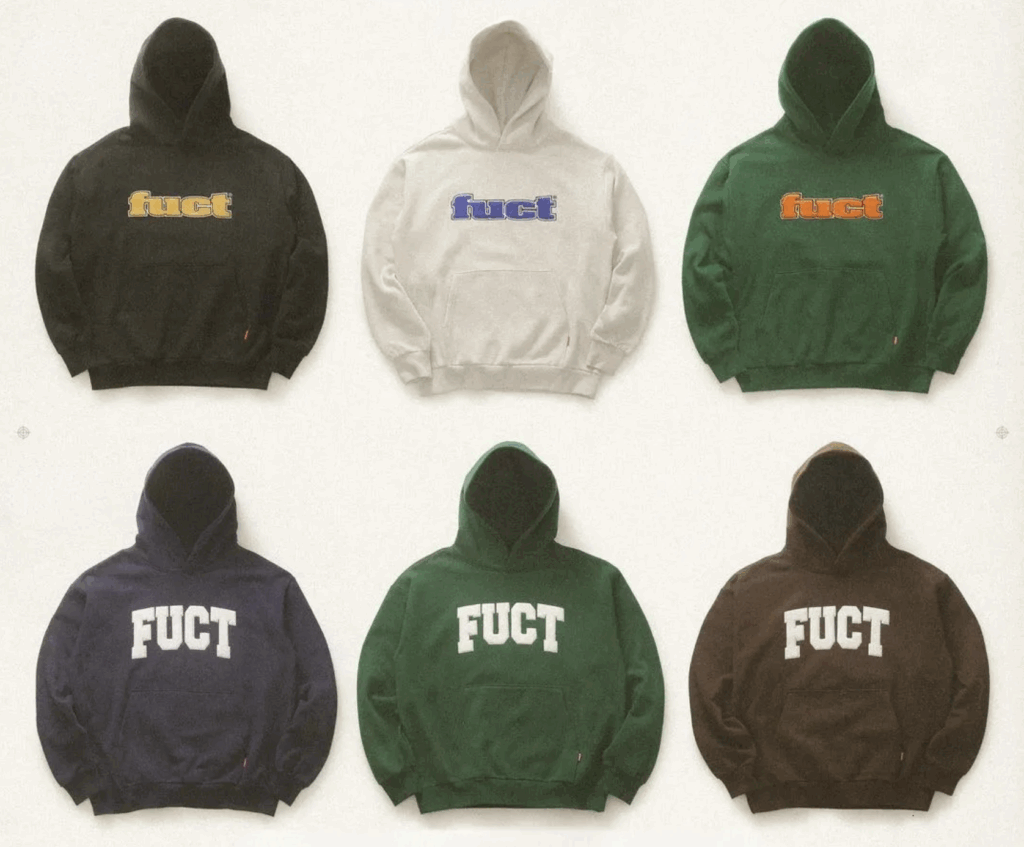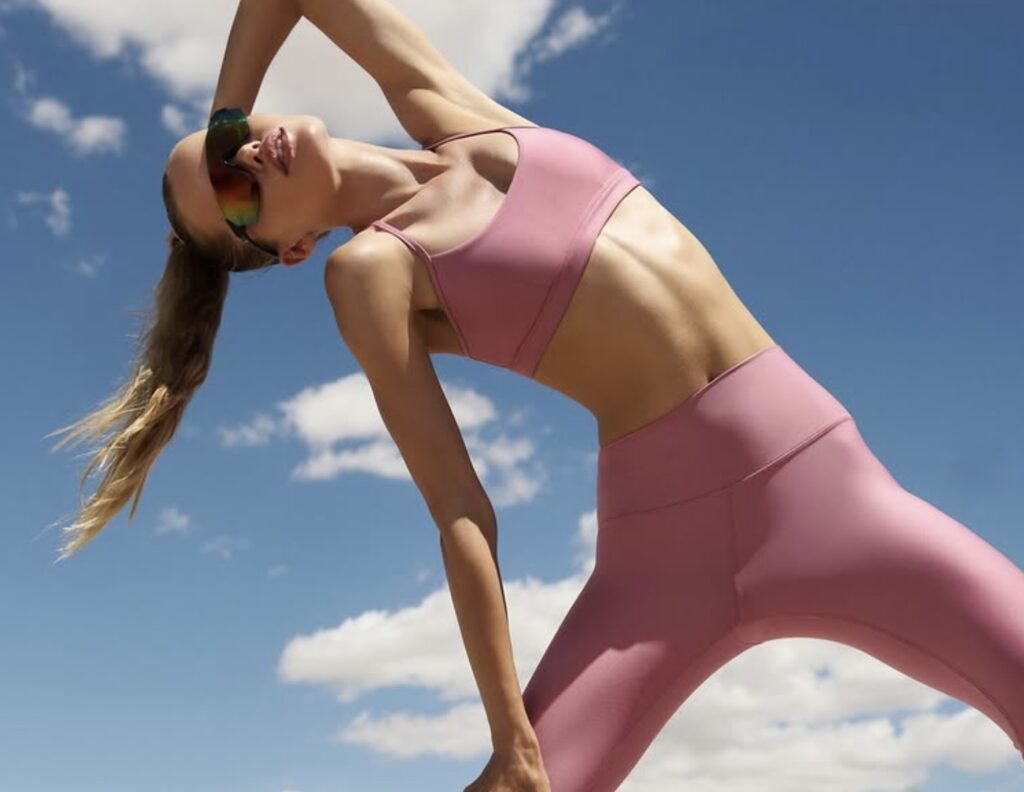The Ohio State University has been handed a win following several rounds before the U.S. Patent and Trademark Office (“USPTO”) in furtherance of its quest to register the word “THE” as a trademark for use on clothing, including “t-shirts, baseball caps and hats.” Almost three years after the school filed an application for registration for “THE” for use in Class 25, the USPTO has granted the registration, marking the success of Ohio State in overcoming pushback from the trademark office and navigating an opposition battle that it waged against Marc Jacobs in connection with an enduring attempt by the LVMH-owned fashion brand to register the word “THE” for use on its own apparel and accessories.
The trademark registration for Ohio State follows from an array of rounds before the USPTO, including (most recently) an August 2021 Office Action, in which an examining attorney for the trademark office asserted that the school’s use of the trademark on the specimen that it filed with its application – which consisted of a t-shirt emblazoned with the word “THE” in large type on the front – was “merely a decorative or ornamental feature of [the] clothing.” As a result, it “does not function as a trademark to indicate the source of [its] clothing and to identify and distinguish [its] clothing from others,” the examining attorney held, preliminarily refusing to register the mark.
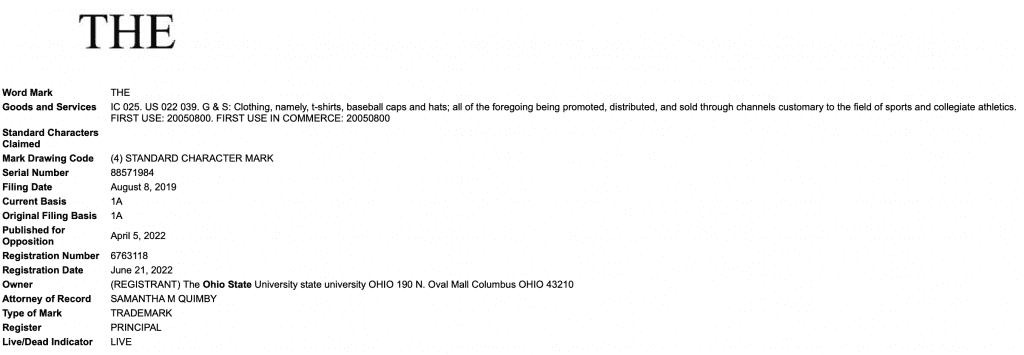
Specifically, the USPTO’s attorney took issue with the “size, location, dominance, and significance of the alleged mark” as depicted in the specimen, namely, because “the applied-for mark, THE, located directly on the upper-center area of the front of the shirt and the front portion of the hat, where ornamental elements often appear.” Beyond that, the examining attorney stated that “the mark is displayed in a relatively large size on the clothing such that it dominates the overall appearance of the goods,” noting that “with respect to clothing, consumers may recognize small designs or discrete wording as trademarks, rather than as merely ornamental features, when located, for example, on the pocket or breast area of a shirt.”
Given the size and placement of the mark, the examining attorney determined that “consumers would view [it] as a decorative or ornamental feature of the goods, rather than as a trademark to indicate the source of [Ohio State’s] goods and to distinguish them from others.”
Early this year, in addition to claiming that its use of the “THE” mark is “not merely ornamental and is worthy of federal trademark registration as it is an indicator of secondary source and sponsorship” thanks to its “use and emphasis on the word ‘THE’… [as] a deliberate, integral, and important element of [its] identity and history,” counsel for Ohio State filed a substitute specimen with the USPTO that showed the mark on a label inside of a t-shirt, prompting the trademark office to publish the mark for opposition and ultimately, issue a registration on June 21.
As for Marc Jacobs, the fashion brand’s own trademark application for registration for the word “THE” for use on clothing and various types of bags is still pending before the USPTO. Jacobs’ application – which it filed in May 2019 – has similarly faced an uphill battle with the USPTO, with an examining attorney issuing a number of refusals to register the mark, including after the brand switched its filing basis from 1(a) to 1(b) in June 2019. A key issue for the USPTO was that Marc Jacobs was using “THE” as “merely a decorative or ornamental feature of [its] clothing,” making it so that the mark does not actually function “as a trademark to indicate the source of [its] clothing and to identify and distinguish” that it from the offerings of other brands.
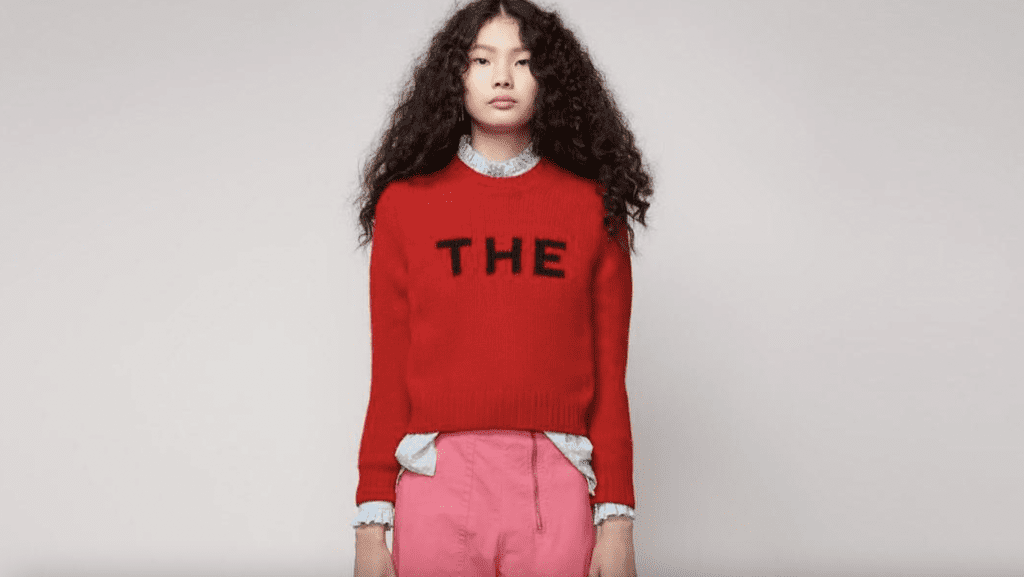
Marc Jacobs’ specimen
Following a final rejection in March 2020, counsel for Marc Jacobs successfully filed a request for reconsideration, and the application was published for opposition in October 2020, and given the green-light by the USPTO by way of a Notice of Allowance in October 2021. (In lieu of Jacobs filing a statement of use, the application is still pending before the USPTO.)
Agreements to Co-Exist
All the while, Ohio State and Marc Jacobs managed to quietly settle the April 2021 opposition that Ohio State initiated before the USPTO’s Trademark Trial and Appeal Board, in which it argued that it has consistently used “THE” as a trademark on athletic merch since at least as early as 2005, more than a decade before Marc Jacobs began to use the mark in connection with its offerings. The opposition fight did not last long, as in the wake of the parties filing amendments to the identification of the goods in their respective applications (Ohio State cited use on clothing “being promoted, distributed, and sold through channels customary to the field of sports and collegiate athletics,” and Jacobs cited use on clothing “being promoted, distributed, and sold through channels customary to the field of contemporary fashion”), counsel for Ohio State alerted the USPTO in August 2021 that it was withdrawing the opposition proceeding that it had previously lodged an effort to block Jacobs’ trademark application for the word “THE” for use on clothing and handbags.
The parties had seemingly decided that they (and their “THE” trademarks) can, in fact, co-exist in their respective spaces in the market – collegiate sports merch vs. fashion – without confusing consumers.
Such a co-existence agreement of sorts (and the potential for subsequent fallout) is hardly the first of its kind in fashion. Something of a similar arrangement is at the heart of the bi-national legal battle that has pitted Valentino S.p.A. against fellow Italian fashion brand Mario Valentino, with the two unrelated entities entering into a co-existence agreement more than 40 years ago in an attempt to avoid legal complications stemming from their nearly-identical monikers.
According to Valentino’s trademark-centric complaint, “Because of their similar names and overlapping goods,” it and Mario Valentino “experienced issues of consumer confusion” almost from the outset. Faced with mounting consumer confusion and a respective “desire to avoid public confusion and conflict, present or future, in any part of the world,” the two companies entered into a legally-binding agreement that dictates exactly how they may respectively use the Valentino name and various “V” logos.
In light of Mario Valentino’s alleged breach of the legally-binding agreement as a result of its sale – and marketing – of lookalike products, Valentino filed suit against its smaller and lesser-known counterpart in a California federal court in July 2019. That case, and similar legal proceedings in a Milan court, are still underway.
Beyond that, a coexistence agreement was entered into by 1661, Inc. – the corporate entity resale platform Goat Group – and London-based brand Goat Fashion after the USPTO refused to register 1661, Inc.’s application for “GOAT” for use in connection with its sneaker marketplace (class 35), citing Goat Fashion’s pre-existing registrations for “GOAT” in classes 25 and 35. In furtherance of the consent agreement, which ultimately enabled 1661, Inc., to obtain a class 35 registration, 20-year old Goat Fashion would “continue to use its GOAT mark for goods and services related to clothing, and 1661, Inc. would limit its use of its GOAT mark to services in connection with its online marketplace … ‘athletic and sporting footwear,’ i.e., sneakers.”
While that agreement appeared to work out for the similarly-named companies for over a year, enabling them to peacefully co-exist in the market, Goat Fashion claimed that things went awry after it refused to consent to 1661’s request to use the GOAT mark on clothing. Instead of agreeing to let 1661 use the mark free and clear, Goat Fashion alleges in the suit that it filed against 1661 in a New York federal court in early 2019 that it “offered to enter into a license agreement with 1661” to enable the company to use the GOAT trademark on clothing.
After Goat Fashion’s motion for a preliminary injunction was granted in September 2020, thereby, barring 1661, Inc. from selling apparel on its buzzy resale marketplace due to the similarity of the two brands’ names and the resulting likelihood that consumers will confuse the two like-named but unaffiliated parties’ goods/services and cause Goat Fashion to suffer “irreparable harm,” the parties settled the suit. On the heels of the parties’ settlement, Goat Fashion founder Jane Lewis revealed that her London-based label would take a new name; it has since become known as Jane.
As for Ohio State’s ability to go after alleged infringers of the “THE” mark, it is limited to the unauthorized use of the mark on related goods in ways that would likely be confusing to consumers as to the source/nature of those allegedly infringing goods. What does that not include? In a tweet on Wednesday, trademark professor Alexandra Roberts stated that Ohio State “certainly can’t enforce against individuals or companies using ‘the’ in regular speech or as part of larger marks, or selling hats branded THE BEST CO. or shirts that say THE QUEEN across the chest, for example.”







